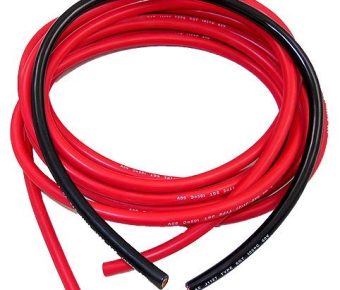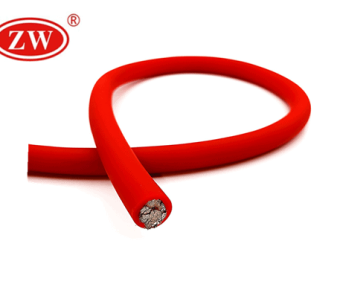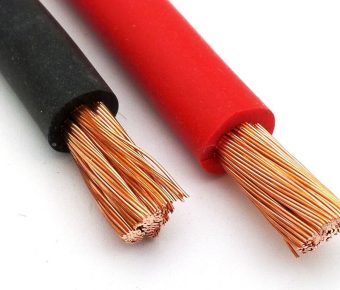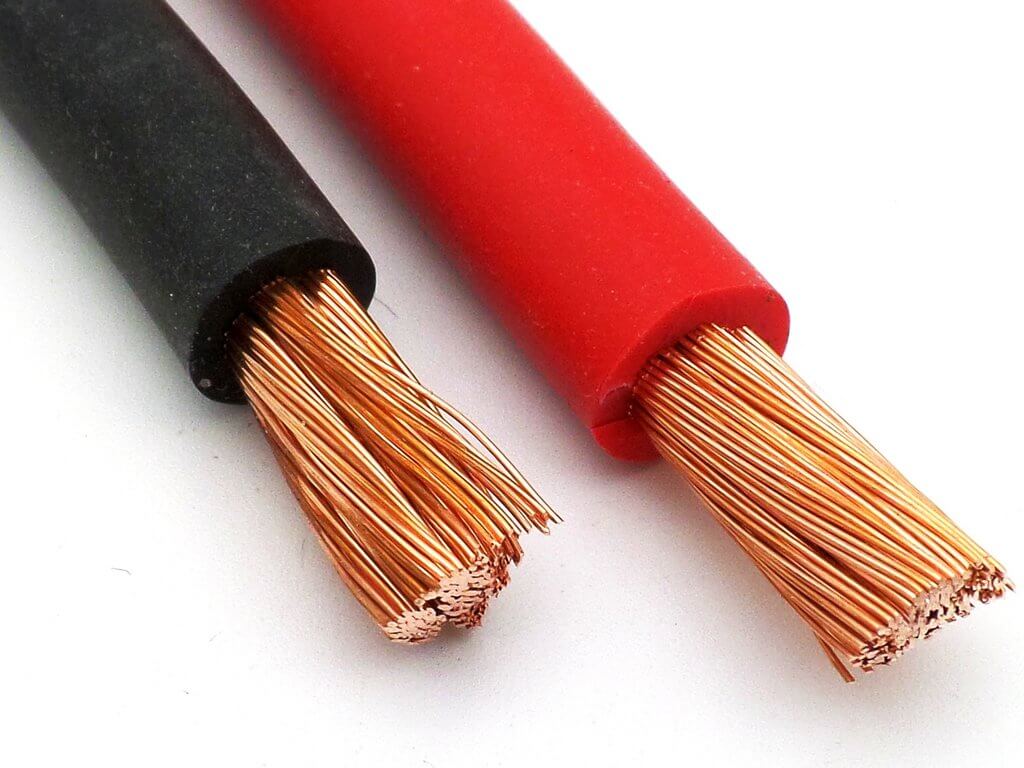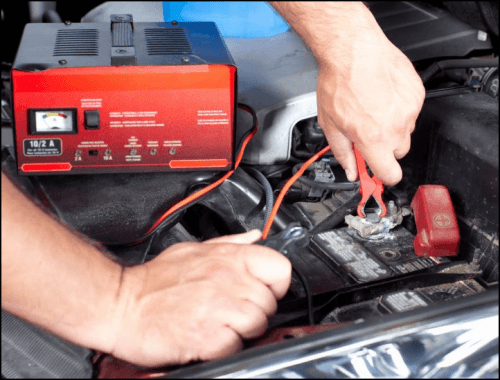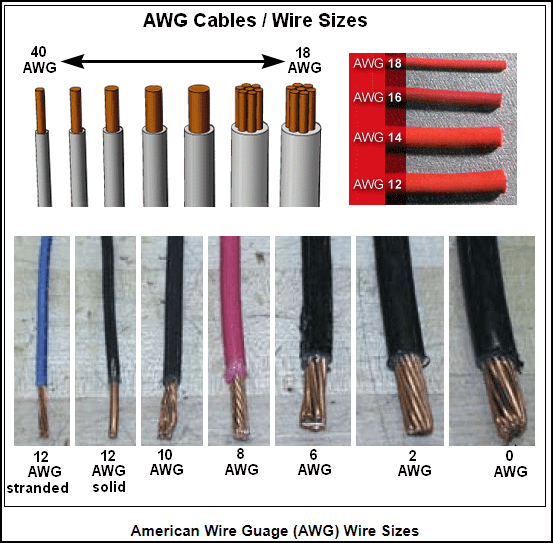- Leading Cable and Wire Manufacturer-ZW
- Battery Cable
Battery Cable
- Class 5 Copper Conductor
Flexible and Durable
Approved by IEC, GB, Rohs
PVC, TPU - Red,Black, Organe
We have all kinds of battery wires such as 4 gauge battery wire, 2 gauge battery wire, 1/0 battery cable etc. Each size of battery wire can carry different currents. Please tell me the current you need and we will help you choose the right battery wire gauge.
Table of Contents
Here’s everything you needed to know about your battery cable
If you’ve landed on this page, chances are that you are in search of a battery cable. And that’s where we have good news and bad news for you! The bad news is that, when you want to buy cables, you just can’t say “I’ll visit a store selling battery cable near me, and buy a good quality cable” – it doesn’t work that way. It’s much more complicated than that!
You’ll need to understand what AWG rating is. You’ll have to know the difference between 1 AWG battery cable and 12v battery wire. You may even have to learn the “AWG” to order your cable – “1 gauge” or “4 gauge automotive wire ”.
But, we promised you good news too…and this is it: No matter what cables you are looking for, truck battery wire, or auto battery wire, or heavy duty battery cable – we’ve got you covered. Our ZW Battery Wire Buyer’s Guide will tell you everything you needed to know about your battery wire. So, let’s get started!
1. What is a battery cable?
A battery cable is a cable that connects the vehicles’ (in the case of an auto battery cable) or sea crafts’ (in the case of a marine battery wire)

Leading Cable and Wire Manufacturer-ZW Page Marine Wire According to IEC, GB, BS Standard Flame
battery terminals to the rest of the crafts’/vehicles’ electrical systems. This includes aspects such as starting, ignition, and systems. These cables come in pairs: Red (positive battery cable) and black (negative).
Typically, battery positive cables lead directly to the vehicles’/crafts’ starter. From there, the connection extends to the lead’s positive starter. The battery cable negative is attached to the vehicles’/crafts’ chassis, which completes a circuit.
2. What gauge is battery cable?
The gauge (“size”) of an insulated battery cable is standardized by an internationally accepted measurement specification called American Wire Gauge (AWG) standard. Under the AWG numbering system, the higher the AWS number assigned to a cable, the smaller its diameter. So, the gauge of an AWG-rated 6 gauge battery cable is smaller than a 4 gauge battery cable.
There is a larger battery wire available too, with gauges less than 1. In the partial table below, the AWG number in the extreme left lists the AWS gauge rating, starting from the smallest (12 gauge) at the bottom, to the largest (0000) at the top.
For example, if you are sourcing larger gauge auto battery cables, you would look for cables with AWG 0 and above. The number of zeros (0, 00, 000, and 0000) progressively increase higher up in the table. This means an AWG gauge 4/0 battery cable is larger than an AWG gauge 2/0 battery cable. As is indicative from the table above, a 1 AWG battery wire has a diameter of 0.2893 inches, however, at 0.3249, an AWG gauge 1/0 battery cable is thicker in diameter.
So, once you’ve decided which cable is best for your application, how do you order your battery cable wire? Typically, you just can’t say “Let me go to a shop selling battery wire near me, and place my order”. You’ll need to ask for specific gauge cable. So, how do you ask for the gauge that you need?
Well, if it’s an AWS 2-rated cable that you want, you may say “I need 2 gauge battery wire”, and the attendant will understand exactly what you need. However, ordering thicker gauge cables is slightly different. For instance, if you want to order 2/0 battery cables, you must ask for “2 gauge cable” (0.3648 inches in diameter). That indicates you want a gauge thicker than 2 gauge (0.2576-inch diameter).
3. Which battery wire is positive?
Sometimes, when your boat, car or truck battery is “dead”, you may want to use a set of jumper cables to recharge it. Auto batteries usually have two metal terminals, one marked with a “-“ (minus) sign, the other has a “+” (plus) sign. These signs indicate where you’ll connect your battery wire.
There are also two sets of cables that you’ll need. Usually, these come as sets, with a black-colored car battery wire, and a corresponding red-colored cable. The black cable is negative, and the red auto battery cable is positive.
So, for example, if your truck battery needs charging, when using your jumper battery terminal wires, always connect the proper cable to the correct battery terminal. In the case above, the 35mm battery cable color will guide you to where you must make the connections:
- Black is a negative battery wire – so it must always be connected to the charged battery’s metal terminal marked “-“, for negative, with the other end attached to a metal ground
- The red truck or car battery wire is the positive cable, so both ends must be connected to battery terminals marked “+”, for positive – one to the charged “+” battery, and the other to the “+” of the dead battery
If you are unsure which is the negative battery wire and which one is positive, it’s best to leave the connection to a professional.
4. What size battery Wire Cable do I need?
Whether it’s a marine battery cable you are dealing with, a car battery cable that you’re considering, or an automotive cable you plan on sourcing, the first thing you must understand, to make the right buy is: What size battery cable is right for this application? Let’s explain what you need to know about the cable sizing process.

Leading Cable and Wire Manufacturer-ZW Page Car Battery Cable According to IEC 60092-3 Series Standard
Battery connector cables power the onboard electrical systems of a vehicle or device, be it a boat, car, truck, or trailer. The two important things to understand about the size of cable you’ll need to provide you the power required for your application are, firstly, how large is the target requiring power.
Also Read: Right-Sourcing And Right-Pricing Your Trailer Wire
The next thing to know is that, based on your target application, you’ll need to size your cable according to the American Wire Gauge (AWG) standards for electrically conductive cables. But the crucial thing to understand about sizing battery wire cable is, that you can’t afford to make mistakes. For example, using a smaller size short battery cable, instead of the “right size”, may generate excessive heat in the power system, posing a fire hazard.
The easiest way to right-size your cable is to understand your applications’ needs and use a standard amperage capacity chart to decide what size cable to use. Two measurements play a critical role in sizing the best battery wires for the most appropriate use:
- Current requirements: This is measured in Amps. For example, each device in your SUV, sedan, or hatchback car – such as AC, stereo, lights, etc. – requires a certain number of Amps to run correctly. A light might use .5 amps, while another connected device might require 5 amps. Therefore, in this case, when sizing your auto battery wire, it’s essential to add up the current requirements for all devices. This yields the maximum amperage required for sizing the wire
- Length of cable required: When current flows from one end of a cable, as it passes through the length of a cable, it meets resistance – which causes voltage drop. Typically, the larger (measured in feet) and thinner (measured in gauge size) the cable is, the more voltage loss you’ll experience. To right-size your car battery extension cable, you’ll therefore require an understanding of the total length of cable that the current will pass through
Whether it’s a heavy-duty battery cable you require, or something for less intensive purposes, by using a Cable Amperage Capacity Chart, like the one shown above, you’ll ensure that you always choose the right battery cable size.
5. Which battery Wire do you connect first?
Whether you are connecting a 1/0 battery cable to wire for car battery or installing a new battery using 12v battery wire, the order in which you connect the cables is typically the same: You always connect the positive end first. Make sure you attach the positive (red/+) cable to the positive (red/+) metal battery terminal first, and then, use a wrench to tighten the connection. Next, do the same with the negative battery cables – black/negative (-) side.
When jump-starting a dead battery using a service craft’s charged battery, the same sequence for connecting the appropriate battery cable color is used. For example, if you have a dead boat or other marine craft, here’s how you would connect the autozone battery cables:
- First, connect the red (positive) jumper cable to the red (positive) terminal on the craft’s dead battery
- Next, attach the other end of the same (red) marine battery cable to the red (positive) terminal of the charged craft’s battery
- You then first attach the negative rv battery cable (black) to the negative terminal of the charged craft’s battery
- Finally, attach the other end of the negative car battery ground cable to any piece of unpainted material on the dead craft
Related article:6 Things You Must Know About GROUND Cable
When understanding which car battery wire to connect first, black and red battery cables. It’s important to know why the order is important. It’s primarily a safety consideration. If the negative cable is connected first, and then the positive, a circuit is completed between the car chassis and battery. At a minimum, this may cause sparking, and possibly an explosion.
For jumpstarting using a battery lead cable, it is recommended that the last connection always is the black (negative) one, which must be to a grounded point (the body of the auto) at a distance to the battery. This is to prevent sparking, which can pose a significant risk of fire or explosions.
6. Where to buy battery Wire?
We hope this Battery Buyers Guide provides you with everything you needed to know about the battery wire you need. Our objective, in providing this information was simple: Whether it’s a power wire that you need, a marine battery, or a car battery wire that you’re looking for – this information should help you. You may even find this Guide extremely helpful in deciding the battery wire size to order, and whether a battery wite is a better choice for your project.
It’s now time for you to source the right type of cable for your application. But, before you ask yourself: Where is the best place to buy battery cable near me – and rush to place an order, consider the following:
- Who the manufacturer and supplier is?
- Are they experienced?
- Have they been in the battery wire business long?
- Do they have the expertise and knowledge to produce high-quality products?
Here, at ZW Cable, we have vast experience in manufacturing and supplying some of the best battery wires in the industry. Our well-respected production process and extremely diligent quality assurance standards ensure our products are of the highest quality available on the market.
Of course, when you’re looking to buy the best battery cables in the business, one factor always matters Pricing! At ZW Cable, we’ve made it a point to make quality and cost a hallmark of our business. While many of our other peers and competitors in the battery cable industry link higher prices to better quality, we’ve priced our battery wire and cables differently: Affordability is what you’ll find when you buy your cables from us.

